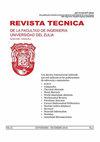Study of the leaching potential in a soil and its depuration capacity: perspectives in a landfill selection
Q Engineering
Revista Tecnica De La Facultad De Ingenieria Universidad Del Zulia
Pub Date : 2020-05-01
DOI:10.22209/rt.v43n2a04
引用次数: 1
Abstract
Many differrent solid wastes are deposited in landfills which may lead to leaching processes with groundwater pollution implications. Complex fractions of organic pollutants may transfer from the soil with multiplex physicochemical interactions which reduce the final soil-borne. In this paper, we study the potential removal of a dye and the potential of water infiltration in each layer of a soil. The results show a removal >98% in the complete profile and in the silty layer (SL) in which more infiltration was found. Therefore, organic fraction in the SL and even more interaction with the aluminum and silicates present, may reduce the dye by physicochemical interaction with log Koc properties. Also, more infiltration in SL indicates a strong interaction between dissolve analytes and soil due to despite a large amount of water cross the silt, low infiltered levels is presented. Finally, pH slightly acid from 4.5 in the sample was increased to 6.7 which indicates basic condition for neutralization, while conductivity was reduced even to values presented in tap water due to ionic exchange capacity by the soil. A preliminary conclusion indicates that removal of the first layer in a landfill reduces the capacity of pollutants removal in soils and, therefore, low physicochemical interactions may lead to the leaching of pollutants to waterbodies. However, further experiments are needed to strengthen this study.土壤浸出潜力及其净化能力的研究:填埋场选择的观点
许多不同的固体废物被堆放在堆填区,这可能导致浸出过程,对地下水造成污染。有机污染物的复杂组分可能通过多重物理化学相互作用从土壤转移,从而减少了最终的土壤携带量。在本文中,我们研究了潜在的去除染料和潜在的水渗透在土壤的每一层。结果表明,在全剖面和粉质层(SL)中,去除率>98%。因此,SL中的有机组分,甚至与存在的铝和硅酸盐更多的相互作用,可能通过与log Koc性质的物理化学相互作用来降低染料。此外,SL中更多的入渗表明溶解物与土壤之间的相互作用很强,因为尽管有大量的水穿过淤泥,但渗透水平很低。最后,样品中的pH值从4.5增加到6.7,这表明了中和的基本条件,而电导率则由于土壤的离子交换能力而降低到自来水中的值。初步结论表明,填埋场第一层的去除降低了土壤中污染物去除的能力,因此,低物理化学相互作用可能导致污染物淋滤到水体中。然而,需要进一步的实验来加强这一研究。
本文章由计算机程序翻译,如有差异,请以英文原文为准。
求助全文
约1分钟内获得全文
求助全文
来源期刊
CiteScore
0.13
自引率
0.00%
发文量
6
审稿时长
>12 weeks
期刊介绍:
La Revista Técnica de Ingeniería, es un órgano de publicaciones científicas y divulgativas de la Facultad de Ingeniería de la Universidad del Zulia. Es una Revista que se publica cuatrimestralmente en tres números correspondiente a un volumen anual. En esta se presentan destacados trabajos de investigación de la comunidad Científico-Tecnológica Nacional e Internacional, proveniente de Universidades, centros de Investigación e Institutos Nacionales y del Extranjero. Cada número circula el primer día de Enero, Mayo y Septiembre, espectivamente, desde el año 2016 al iniciar como Revista en formato digital.

 求助内容:
求助内容: 应助结果提醒方式:
应助结果提醒方式:


